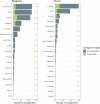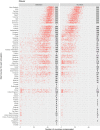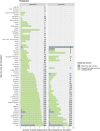The phytosanitary risks posed by seeds for sowing trade networks
- PMID: 34847168
- PMCID: PMC8631629
- DOI: 10.1371/journal.pone.0259912
The phytosanitary risks posed by seeds for sowing trade networks
Abstract
When successful, the operation of local and international networks of crop seed distribution or "seed systems" ensures farmer access to seed and impacts rural livelihoods and food security. Farmers are both consumers and producers in seed systems and benefit from access to global markets. However, phytosanitary measures and seed purity tests are also needed to maintain seed quality and prevent the spread of costly weeds, pests and diseases, in some countries regulatory controls have been in place since the 1800s. Nevertheless, seed contaminants are internationally implicated in between 7% and 37% of the invasive plant species and many of the agricultural pests and diseases. We assess biosecurity risk across international seed trade networks of forage crops using models of contaminant spread that integrate network connectivity and trade volume. To stochastically model hypothetical contaminants through global seed trade networks, realistic dispersal probabilities were estimated from quarantine weed seed detections and incursions from border security interception data in New Zealand. For our test case we use contaminants linked to the global trade of ryegrass and clover seed. Between 2014 and 2018 only four quarantine weed species (222 species and several genera are on the quarantine schedule) warranting risk mitigation were detected at the border. Quarantine weeds were rare considering that average import volumes were over 190 tonnes for ryegrass and clover, but 105 unregulated contaminant species were allowed in. Ryegrass and clover seed imports each led to one post-border weed incursion response over 20 years. Trade reports revealed complex global seed trade networks spanning >134 (ryegrass) and >110 (clover) countries. Simulations showed contaminants could disperse to as many as 50 (clover) or 80 (ryegrass) countries within 10 time-steps. Risk assessed via network models differed 18% (ryegrass) or 48% (clover) of the time compared to risk assessed on trade volumes. We conclude that biosecurity risk is driven by network position, the number of trading connections and trade volume. Risk mitigation measures could involve the use of more comprehensive lists of regulated species, comprehensive inspection protocols, or the addition of field surveillance at farms where seed is planted.
Conflict of interest statement
CEB received funding in the form of salary from AgResearch Ltd. AgResearch Ltd is a government owned research institute whose funding was provided by a public sector agency. This does not alter our adherence to PLOS ONE policies on sharing data and materials.
Figures









References
-
- Jaffee S, Srivastava J. The roles of the private and public sectors in enhancing the performance of seed systems. The World Bank Research Observer. 19949: 97–117.
-
- Tripp R, Louwaars N. Seed regulation: choices on the road to reform. Food Policy. 1997;22: 433–446. doi: 10.1016/S0306-9192(97)00033-X - DOI
-
- Hampton JG, Young KA. Quality herbage seed—germination and contamination: 1. Ryegrass. Proceedings of the New Zealand Grassland Association. 1985;46: 191–194.
-
- Matthews S, Noli E, Demir İ, Khajeh-Hosseini M, Wagner M-H. Evaluation of seed quality: From physiology to international standardization. Seed Science Research. 2012;22. doi: 10.1017/S0960258511000365 - DOI
-
- ISTA. International Rules for Seed Testing. International Rules for Seed Testing. Bassersdorf, Switzerland: International Seed Testing Association; 2021. Available: https://www.ingentaconnect.com/content/ista/rules/.
Publication types
MeSH terms
LinkOut - more resources
Full Text Sources

